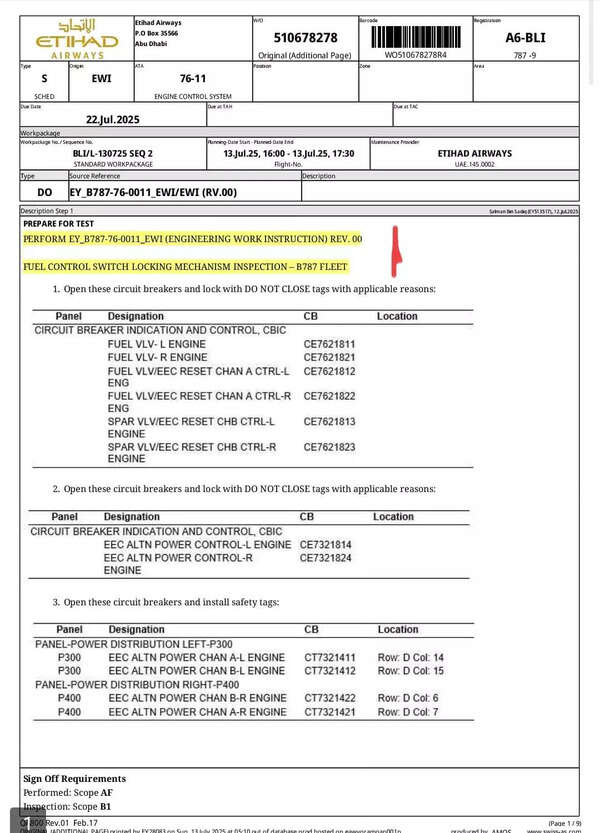ARTICLE AD BOX

Following the Air India AI-171 accident investigation, Etihad Airways ordered an inspection of a Boeing 787's fuel control switch locking mechanism after a flight diverted back to Abu Dhabi. The focus is on a potential locking system failure, as highlighted in a prior safety bulletin, which could lead to unintended fuel cutoff.
MUMBAI: An Etihad Airways Boeing 787 aircraft underwent a fuel control switch locking mechanism inspection on Sunday after the airline issued an engineering work order for the aircraft that diverted back to Abu Dhabi minutes after it took off for Hyderabad.
The locking mechanism of fuel control switches on Boeing aircraft is at the centre of investigation into the June 12 Air India AI-171 Boeing 787 accident which killed 270 people. TOI has sought a comment from Etihad.
India’s Aircraft Accident Investigation Bureau (AAIB) had released the preliminary report into the AI 171 accident on Saturday, July 12. The Etihad engineering work order came a day later, on July 13. TOI has accessed the said document, it instructs engineers to inspect whether the locking mechanism on the fuel control supply switches in the said Boeing 787 aircraft (registration number: A6-BLI) is working.Why is this particular locking feature on Boeing aircraft in focus now?The AAIB report said that fuel control switches on Air India B787 transitioned from ``Run’’ to ‘’Cutoff”’ three seconds after the aircraft lifted off from Ahmedabad runway.

The report said: “In the cockpit voice recording, one of the pilots is heard asking the other why did he cut off (the fuel supply). The other pilot responded that he did not do so".
Fuel control switches have two modes, Run, to start and continue the fuel supply and Cutoff to discontinue the fuel supply. It cannot be inadvertently moved because of a locking mechanism. The switch has to be lifted and then moved forward where it drops into a slot and this starts the fuel supply. Similarly, to cut the fuel supply the switch has to be lifted and pulled back into a slot.So how did the fuel control switches move to cut off on the Air India aircraft?The AAIB report referred to a 2018 safety bulletin issued by the US aviation regulator which instructed airlines to look out for a locking system failure in the fuel control switches. A faulty locking system could cut off fuel supply to the engines without pilots input. A faulty locking system would move the fuel switches from top to bottom__ or from run fuel to cutoff fuel__without the need to lift it. The AAIB report said that Air India did not carry out the said inspection as it was not deemed mandatory. Following the release of the report, certain sections of the foreign media, especially those from Boeing’s home country, the US have pushed the narrative that one of the pilots in a suicidal move cut off the fuel switches.The Etihad engineering work order then is significant in that context as it brings the focus on the locking mechanism of fuel control switches on Boeing aircraft.The Etihad work order follows the instruction issued in the same 2018 safety bulletin. “Attempt to gently move (without applying excessive force) the Left (L) fuel control switch. Attempt to gently move (without applying excessive force) the Left (L) fuel control switch on the P10 Control Stand from " CUTOFF " to " RUN "without lifting the switch.
Attempt to gently move (without applying excessive force) the Left (L) fuel control switch from "CUTOFF" to "RUN" without lifting the switch. If the switch cannot be moved without lifting, the locking feature is functional/ No further action is needed.
Proceed to next step. If the switch can be moved freely without lifting, the locking feature has failed or is disengaged. Replace the Thrust Control Module (TCM)”The big question surrounding the AI accident on whether the fuel control switch transitioned to cutoff because of a mechanical problem with its locking system gets more weightage in the context of the Etihad order.The said aircraft was to operate Etihad flight EY352 on July 13. The aircraft took off and reached 9500 feet when the pilots diverted it back to Abu Dhabi. The said engineering work order was issued following the diversion.



.png)
.png)
.png)
















 4 hours ago
4
4 hours ago
4









 English (US) ·
English (US) ·